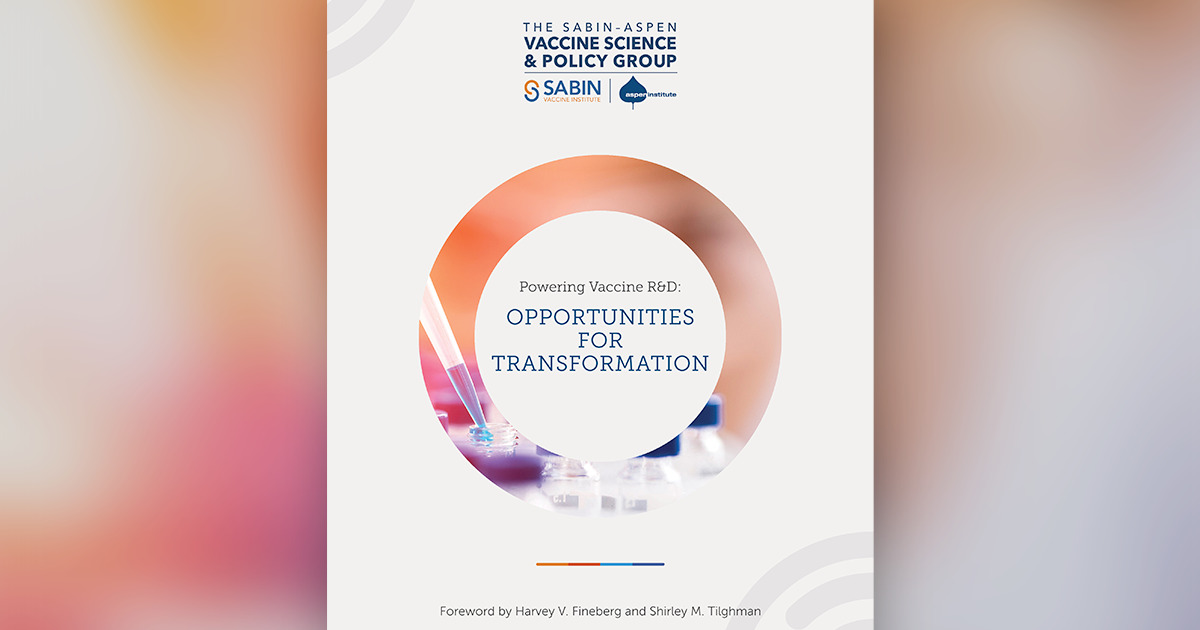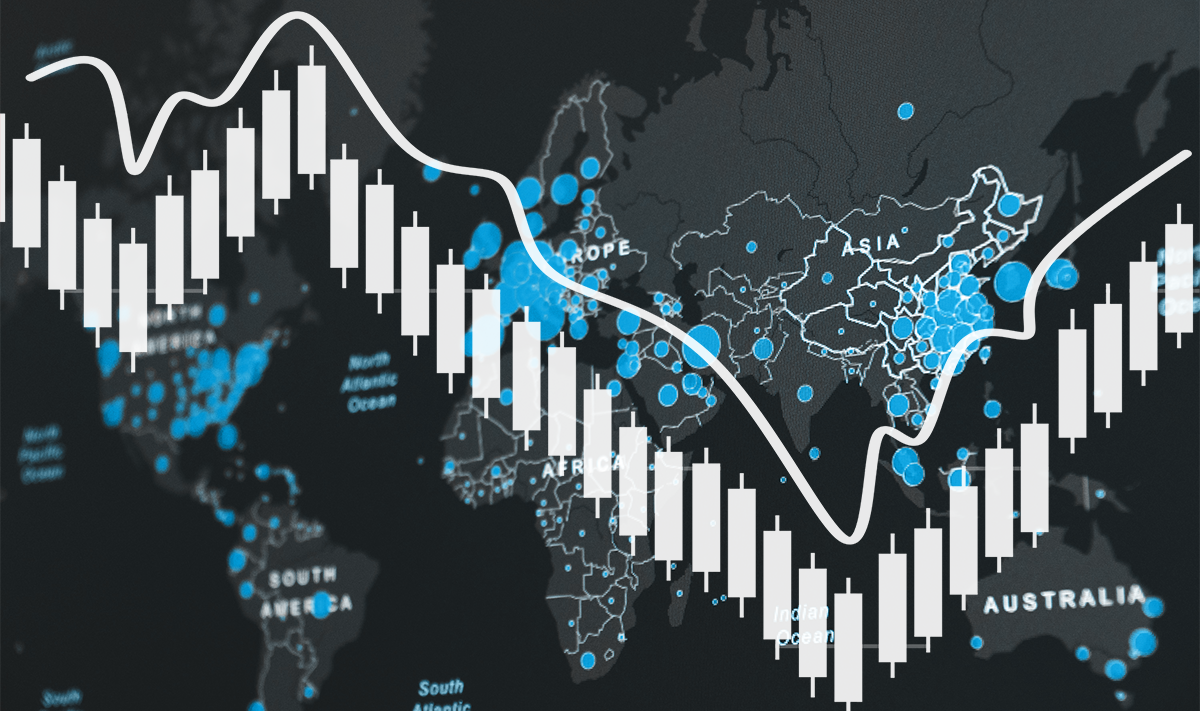From This Year Forward
This late November headline from National Public Radio says it all: “Merriam-Webster’s 2021 word of the year is, of course, ‘vaccine.’”
Taking stock of this tumultuous year in the spotlight, the Sabin-Aspen Vaccine Science & Policy Group finds much to celebrate, alongside the many challenges that inspire our work. Several recent scientific and policy advances encourage our continued efforts to fortify the pillar of global health security provided by vaccines.
First and foremost, following the record-shattering development of multiple effective vaccines against SARS-CoV-2, their equally phenomenal rollout in 2021 delivered at least one dose to more than half the global population. These achievements demonstrate what is possible when we galvanize scientific, human, policy-making and financial resources.
Yet while the global effort to deploy vaccines against COVID-19 shows how quickly the world can react to pandemic threats, several events in 2021 revealed how our response to the emergence of SARS-CoV-2 fell short. During this year, the official death toll from COVID-19—a vast underestimate—more than doubled, exceeding 5 million in November. Viral variants arose to ignite fresh waves of illness and death, and to challenge the effectiveness of existing vaccines and therapeutics. The pandemic-sparked global recession—the worst since the end of World War II—continues to devastate lives and livelihoods worldwide. Inequitable distribution of COVID-19 vaccines, reflecting broader global inequities, magnified the pandemic’s impact in low- and middle-income countries (LMICs), where its aftershocks doubtless will reverberate longest.
Preparation is response
The world will face more pandemic threats—possibly while still fighting COVID-19—for which we are demonstrably unready. As the 2021 Global Health Security Index report concludes,
Although many countries were able to quickly develop capacities to address COVID-19, all countries remain dangerously unprepared for meeting future epidemic and pandemic threats. A great opportunity exists, however, to make new capacities more durable to further long-term gains in preparedness.
Rising to this challenge, proposals to build global pandemic preparedness frameworks commanded the agenda at several high-profile multilateral convenings this year, informed by the work of multiple expert panels and civil society organizations. The G7, for example, set the goal of developing and deploying safe, effective diagnostics, therapeutics, and vaccines within 100 days of the declaration of a Public Health Emergency of International Concern by the World Health Organization (WHO).
The work of the Sabin-Aspen Group, among that of a growing body of thought leaders, makes the case that pandemic preparedness necessarily entails addressing structural failures in vaccine research and development (R&D) that for decades have slowed the introduction and improvement of vaccines. Such obstacles to vaccine access received long overdue attention this year at the World Health Assembly, G7, G20, and at the United Nations General Assembly and associated Global COVID-19 Summit at the White House.
Since well before SARS-CoV-2 emerged, the imperative to expand global access to vaccines has driven the Sabin-Aspen Group’s reimagining of vaccine R&D to drive transformative scientific innovation. In pursuit of this vision, the Group examined how elements of the COVID-19 response that accelerated the development of safe, effective vaccines could be sustained and applied to address additional infectious disease threats, including multiple pathogens with pandemic potential. The deliberations leading to the report, Powering Vaccine R&D: Opportunities for Transformation, were grounded in these principles:
- Access to safe and effective vaccines for all people is a moral imperative
- The devastation wrought by COVID-19 demands that we revisit and restructure vaccine R&D
- Scientific breakthroughs and new technology expand what is possible
- A top-down, bottom-up approach guided by coordinated leadership advances vaccine R&D most effectively
- Public confidence in R&D is imperative to reducing vaccine-preventable diseases.
Released in May 2021, the report joined the ongoing global conversation on pandemic preparedness.
As this year closes and the cast of omicron’s shadow remains uncertain, the ever-relevant findings highlight the resounding call to change the future by learning the hard lessons of the present.
Roadblocks to vaccine access
Key challenges to rapid development and deployment of vaccines include low manufacturing capacity, systemic inefficiencies and inequity, lack of preparedness, and inadequate coordination of the many parts of the vaccine ecosystem. These shortcomings result in unclear vaccine demand commitments, inconsistent rules and regulations for vaccine development, and delays and inequities in vaccine manufacture and distribution.
Restrictions imposed on vaccine access begin with vaccine developers’ decisions about which scientific avenues and disease targets to pursue—decisions that necessarily must be governed by market and financial realities. Promising vaccine candidates encounter an approvals process lacking international standards for quality, labelling, efficacy and safety that forces developers to meet a myriad of local requirements, and possibly to conduct bespoke clinical trials, regardless of epidemiological needs. Such associated costs and delays can drive developers away from licensing vaccines in jurisdictions where demand nonetheless exists for their products.
As the COVID-19 experience revealed, access to vaccines is also constrained by the dearth and mal-distribution of manufacturing capacity. These limitations reflect the overall risk of investing in the development of vaccines as compared with other pharmaceuticals, as well as the specific risk entailed in building manufacturing facilities in anticipation of the approval of a promising candidate. In the case of COVID-19 vaccines, advance manufacturing risk was assumed by national governments and COVAX, but these crisis-driven investments could not overcome global deficits in vaccine manufacturing capacity.
Among the most hopeful developments sparked by the pandemic, collaborations of unprecedented scope and scale significantly accelerated the world’s response to COVID-19. Independent networks of laboratories grew virus and shared samples. The Global Initiative on Sharing Avian Influenza Data (GISAID), largely maintained by volunteers, became a public clearinghouse where scientists from around the globe shared sequencing information. Laboratories with level 3 and 4 capabilities – almost all in high-income countries and most already operating at capacity – scrambled to access samples, establish animal models and begin research. Such transdisciplinary networks are the engines of scientific breakthroughs and new technologies that can improve the world’s response to future pandemics. To build a firm foundation for pandemic preparedness in the vaccine R&D ecosystem, we must build and strengthen connections between and across basic and translational research, formulation, manufacturing and regulatory entities worldwide.
Better vaccines, faster
The following elements of the report recommendations align with multiple COVID-inspired efforts toward pandemic preparedness in emphasizing the crucial role of a modernized, efficient vaccine R&D ecosystem in protecting the world from emerging pathogens:
- Collaboration: Ensuring that the vaccine R&D ecosystem responds effectively to novel threats requires investment in developing products that might never be needed. Unprecedented levels of collaboration across sectors and cooperation in R&D can build defenses against unpredictable pathogens.
- Financial commitment: Accelerating COVID-19 vaccine availability by a single month could have saved as much as US$500 billion. Investment in a reserve fund equivalent to some fraction of this amount would fund research, testing, and at-risk manufacturing for pandemic-responsive vaccines, as well as their distribution and administration. Pandemic financing is currently being explored by a G20 task force.
- Transdisciplinary basic research: COVID-19 vaccines were a “decades-long overnight success story” that must be repeated to protect the world from future pandemics. The path to future breakthroughs lies in the intentional engagement of researchers from multiple disciplines in creative, collaborative problem-solving.
- Distributed clinical research: International networks of clinical sites that reflect the world’s diversity, where trials are conducted according to globally agreed-upon master protocols, can accelerate evaluation of vaccines and increase confidence in trial results. By employing innovative statistical techniques and diversifying and distributing effort, researchers may be able to measure effects, abandon futile trial arms and establish optimal dosages in multiple contexts and populations more quickly.
- Reimagined clinical trials: Identifying immune correlates of protection is key to streamlining vaccine evaluation. Once such correlates are identified, vaccines can be approved on the basis of smaller and faster trials that bridge from surrogate endpoints established from initial efficacy studies. In some cases, human challenge trials may appropriately and ethically accelerate determinations of vaccine efficacy.
- Vaccination is the goal: Vaccine R&D efforts must from the outset reflect programmatic and policy constraints on the success of vaccination campaigns. Trials should evaluate efficacy in multiple subpopulations and should aim to determine the relative benefits to various demographic groups of different vaccines against the same pathogen, and they should be followed by careful post-marketing safety surveillance.
- Regulatory harmonization and innovation: Harmonization of global regulatory standards and approaches, including requirements for surrogate endpoints and post-marketing surveillance, will streamline the evaluative process without compromising vaccine safety. Crisis standards should be developed for vaccines against emergent pathogens with pandemic potential, modeled on those applied to COVID-19 vaccines by the US Food and Drug Administration and the European Medicines Agency.
The arrival of 2022 demands that we look forward and vigorously apply lessons learned in 2021. We must do what it takes to advance vaccines beyond their momentary fame as the word on everyone’s lips, toward the promise they hold to guard everyone’s wellbeing.



